Formation Mechanisms of the “5·31” Record-Breaking Extreme Heavy Rainfall Process in South China in 2021
Abstract
1. Introduction
2. Data and Method
3. Overview of the “5·31” Precipitation Process
3.1. Spatio-Temporal Distribution Characteristics of the Rainfall
3.2. Atmospheric Circulation Characteristics
4. Formation Mechanism of the Extreme Heavy Rainfall in Longhua of Longmen
4.1. Abundant Water Vapor Conditions
4.2. High Efficiency of Water Vapor Condensation
4.3. Causes of the Long Duration of This Heavy Rainfall Process
4.3.1. Effects of the Mesoscale Surface Convergence Line
4.3.2. Train Effect of Multi-Cell Storms
5. Conclusions
Author Contributions
Funding
Institutional Review Board Statement
Informed Consent Statement
Data Availability Statement
Conflicts of Interest
References
- Huang, Y.J.; Liu, Y.B.; Liu, Y.W.; Li, H.Q.; Jason, C.K. Budget analyses of a record-breaking rainfall event in the coastal metropolitan city of Guangzhou, China. J. Geophys. Res. Atmos. 2019, 124, 9391–9406. [Google Scholar] [CrossRef]
- Li, M.X.; Luo, Y.L.; Zhang, D.L.; Chen, M.X.; Wu, C.; Yin, J.F.; Ma, R.Y. Analysis of a record-breaking rainfall event associated with a monsoon coastal megacity of south china using multisource data. IEEE Trans. Geosci. Remote Sens. 2020, 59, 6404–6414. [Google Scholar] [CrossRef]
- Yin, J.F.; Zhang, D.L.; Luo, Y.L.; Ma, R.Y. On the extreme rainfall event of 7 May 2017 over the coastal city of Guangzhou. Part I: Impacts of urbanization and orography. Mon. Wea. Rev. 2020, 148, 955–979. [Google Scholar] [CrossRef]
- Meng, W.G.; Wang, Y.Q. A diagnostic study on heavy rainfall induced by landfalling Typhoon Utor (2013) in South China: 1. Rainfall asymmetry at landfall. J. Geophys. Res. Atmos. 2016, 121, 12781–12802. [Google Scholar] [CrossRef]
- Liu, L.; Xu, J.; Wang, Y.Q.; Duan, Y.H. Contribution of recycling of surface precipitation to landfalling tropical cyclone rainfall: A modeling study for Typhoon Utor (2013). J. Geophys. Res. Atmos. 2019, 124, 870–885. [Google Scholar] [CrossRef]
- Li, H.Q.; Wan, Q.L.; Peng, D.D.; Liu, X.T.; Xiao, H. Multiscale analysis of a record-breaking heavy rainfall event in Guangdong, China. Atmos. Res. 2020, 232, 104703. [Google Scholar] [CrossRef]
- Zeng, Z.L.; Chen, Y.; Wang, D.H. Observation and mechanism analysis for a record-breaking heavy rainfall event over Southern China in August 2018. Chin. J. Atmos. Sci. 2020, 44, 695–715. (In Chinese) [Google Scholar]
- Chen, G.; Zhao, K.; Lu, Y.H.; Zheng, Y.Y.; Xue, M.; Tan, Z.M.; Xu, X.; Huang, H.; Chen, H.N.; Xu, F.; et al. Variability of microphysical characteristics in the “21·7” Henan extremely heavy rainfall event. Sci. China Earth Sci. 2022, 10, 1861–1878. [Google Scholar] [CrossRef]
- Luo, Y.H.; Du, Y. The Roles of Low-level Jets in “21·7” Henan extremely persistent heavy rainfall event. Adv. Atmos. Sci. 2023, 40, 350–373. [Google Scholar] [CrossRef]
- Wei, P.; Xu, X.; Xue, M.; Zhang, C.Y.; Wang, Y.; Zhao, K.; Zhou, A.; Zhang, S.S.; Zhu, K.F. On the key dynamical processes supporting the 21.7 Zhengzhou record-breaking hourly rainfall in China. Adv. Atmos. Sci. 2023, 40, 337–349. [Google Scholar] [CrossRef]
- Lin, L.X.; Feng, Y.R.; Huang, Z.; Zeng, C.; Wu, Z.F.; Liu, Y.C.; Zeng, Q. Technical Manual of Weather Forecast in Guangdong Province; Meteorol Press: Beijing, China, 2006; pp. 97–126. (In Chinese) [Google Scholar]
- Chen, F.L.; Li, M.H.; Jiang, S.; Huang, C.; Zeng, D.D.; Chen, Y. An analysis of the climatological characteristics of precipitation in a heavy rain center of Northern Guangdong. Guangdong Meteorol. 2020, 42, 10–14. (In Chinese) [Google Scholar]
- Chen, G.X.; Lan, R.Y.; Zeng, W.X.; Pan, H.; Li, W.B. Diurnal variations of rainfall in surface and satellite observations at the monsoon coast (South China). J. Clim. 2018, 31, 1703–1724. [Google Scholar] [CrossRef]
- Du, Y.; Chen, G.X. Heavy rainfall associated with double low-level jets over Southern China. Part I: Ensemble-based analysis. Mon. Wea. Rev. 2018, 146, 3827–3844. [Google Scholar] [CrossRef]
- Pu, Y.L.; Hu, S.; Luo, Y.L.; Liu, X.T.; Hu, L.H.; Ye, L.M.; Li, H.Q.; Xia, F.; Gao, L.Y. Multiscale perspectives on an extreme warm-sector rainfall event over coastal South China. Remote Sens. 2022, 14, 3110. [Google Scholar] [CrossRef]
- Ye, L.M.; Liu, X.T.; Pu, Y.L.; Li, H.Q.; Xia, F.; Xu, B.Y. Contrasts in the evolution and microphysical features of two convective systems during a heavy rainfall event along the coast of South China. Atmosphere 2022, 13, 1549. [Google Scholar] [CrossRef]
- Zhang, H.H.; Rao, X.N.; Guo, Z.Y.; Liu, X.T.; Yu, X.D.; Chen, X.D.; Li, H.Q.; Zhang, J.J.; Zeng, G.Y.; Chen, S.D. Detailed evolution characteristics of an inclined structure hailstorm observed by polarimetric radar over the South China coast. Atmosphere 2022, 13, 1564. [Google Scholar] [CrossRef]
- Li, H.Q.; Huang, Y.J.; Hu, S.; Wu, N.G.; Liu, X.T.; Xiao, H. Roles of terrain, surface roughness, and cold pool outflows in an extreme rainfall event over the coastal region of South China. J. Geophys. Res. Atmos. 2021, 126, e2021JD035556. [Google Scholar] [CrossRef]
- Feng, L.; Hu, S.; Liu, X.T.; Li, H.Q.; Xiao, H.; Li, X.H.; Lai, R.Z.; Lin, Q. Comparison of microphysical characteristics between warm-sector and frontal heavy rainfall in the South of China. J. Trop. Meteorol. 2023, 29, 87–100. [Google Scholar]
- Liu, X.T.; Ruan, Z.; Hu, S.; Wan, Q.L.; Liu, L.P.; Luo, Y.L.; Hu, Z.Q.; Li, H.Q.; Xiao, H.; Lei, W.Y.; et al. The Longmen cloud physics field experiment base, China Meteorological Administration. J. Trop. Meteorol. 2023, 29, 1–15. [Google Scholar]
- Si, D.; Xu, H.M.; Wen, M.; He, J.H. Analysis of the westward extension of western pacific subtropical high during a heavy rain period over southern china in June 2005. J. Trop. Meteorol. 2008, 14, 93–96. [Google Scholar]
- Xiong, W.B.; Li, J.N.; Yao, C.; Wang, A.Y.; Fong, S.K. Analyzing continuous rainstorm in Southern China in June 2005. J. Trop. Meteorol. 2007, 23, 90–97. (In Chinese) [Google Scholar]
- He, L.F.; Zhou, Q.L.; Chen, T. The evolution characteristics of mid-latitude and low-latitude synoptic systems during the “05·6” heavy rain event in South China. J. Appl. Meteorol. Sci. 2010, 21, 385–394. (In Chinese) [Google Scholar]
- Wang, T.; Wu, C.S.; Fong, S.K. A Numerical Study of a Mesoscale Convective System Associated with the Heavy Rain Event over Guangdong Province in June 2005. Chin. J. Atmos. Sci. 2008, 32, 184–196. (In Chinese) [Google Scholar]
- Xia, R.D.; Zhao, S.X. Diagnosis and modeling of meso-β-scale systems of heavy rainfall in warm sector ahead of front in South China (middle part of Guangdong Province) in June 2005. Chin. J. Atmos. Sci. 2009, 33, 468–488. (In Chinese) [Google Scholar]
- Doswell, C.A., III; Brooks, H.E.; Maddox, R.A. Flash flood forecasting: An ingredients-based methodology. Wea. Forecasting. 1996, 11, 560–581. [Google Scholar] [CrossRef]
- Sun, J.S.; Tao, Z.Y. Some essential issues connected with severe convective weather analysis and forecast. Meteor Mon. 2012, 38, 164–173. (In Chinese) [Google Scholar]
- Yu, X.D. Nowcasting thinking and method of flash heavy rain. Torrential Rain Disasters 2013, 32, 202–209. (In Chinese) [Google Scholar]
- Feng, L.; Lu, H.Q.; Li, F.; Liu, X.T.; Xiao, H.; Pan, X.; Xia, F. Characteristics of the raindrop size distribution in a squall line measured by two-dimensional video disdrometer in Guangdong. J. Trop. Meteorol. 2020, 36, 626–637. (In Chinese) [Google Scholar]
- Sun, J.S.; Dai, J.H.; He, L.F.; Zheng, Y.Y.; Yu, X.D.; Xu, A.H. Basic Principles and Technical Methods of Severe Convective Weather Forecast-Severe Convective Weather Forecast Manual of China; Meteorological Press: Beijing, China, 2014; pp. 28–30. (In Chinese) [Google Scholar]

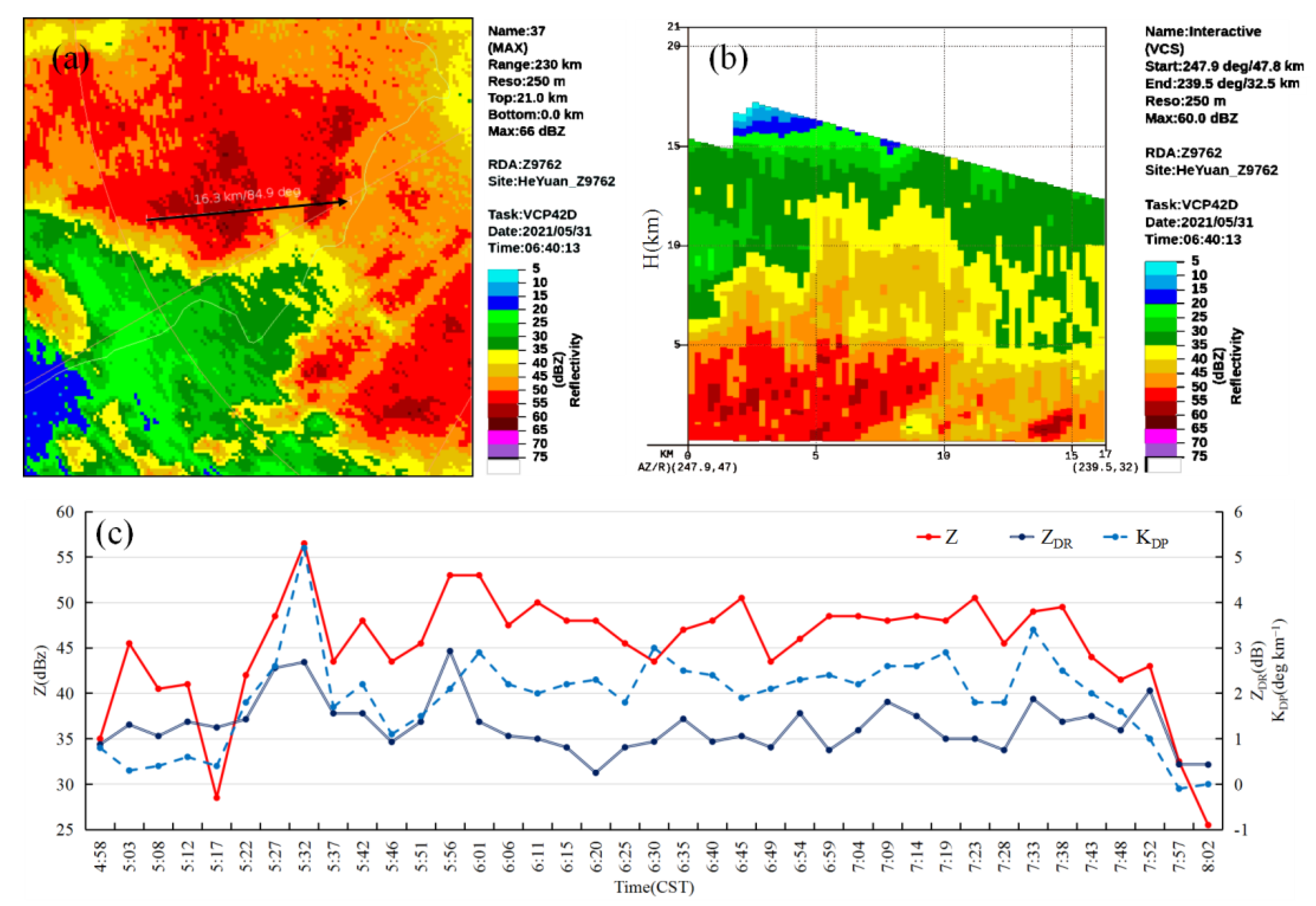
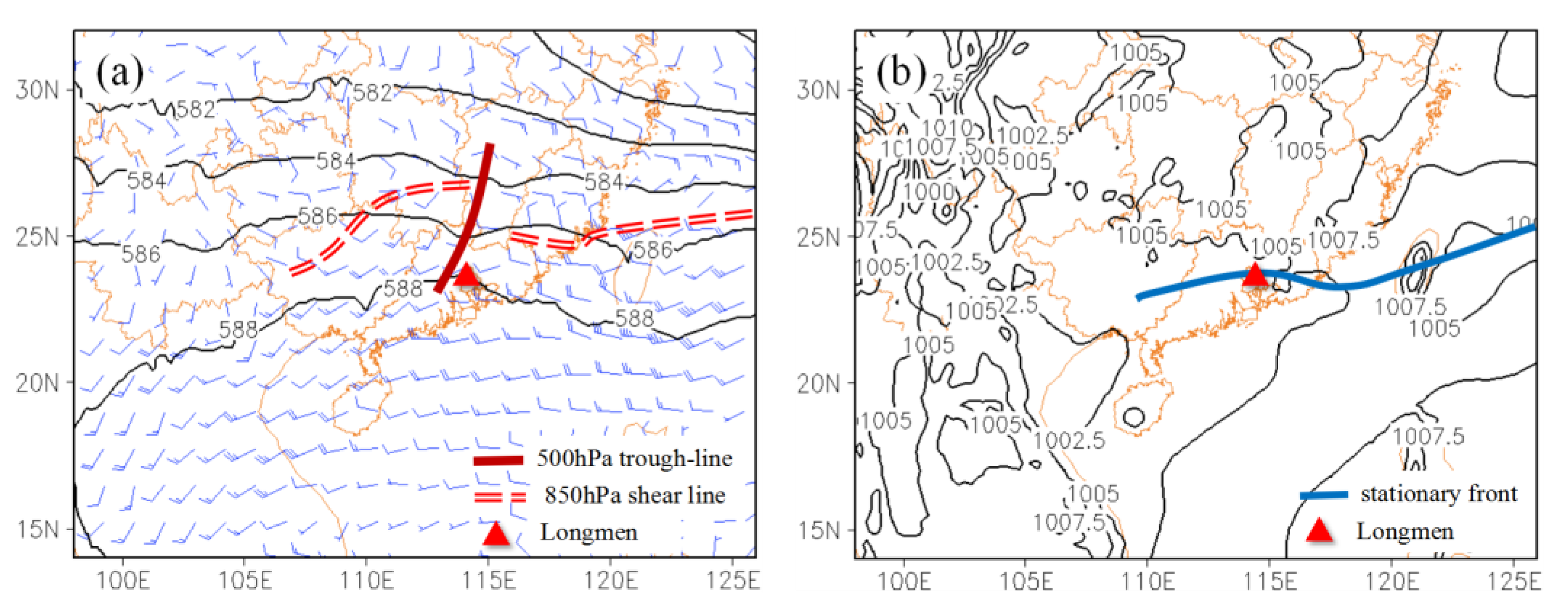


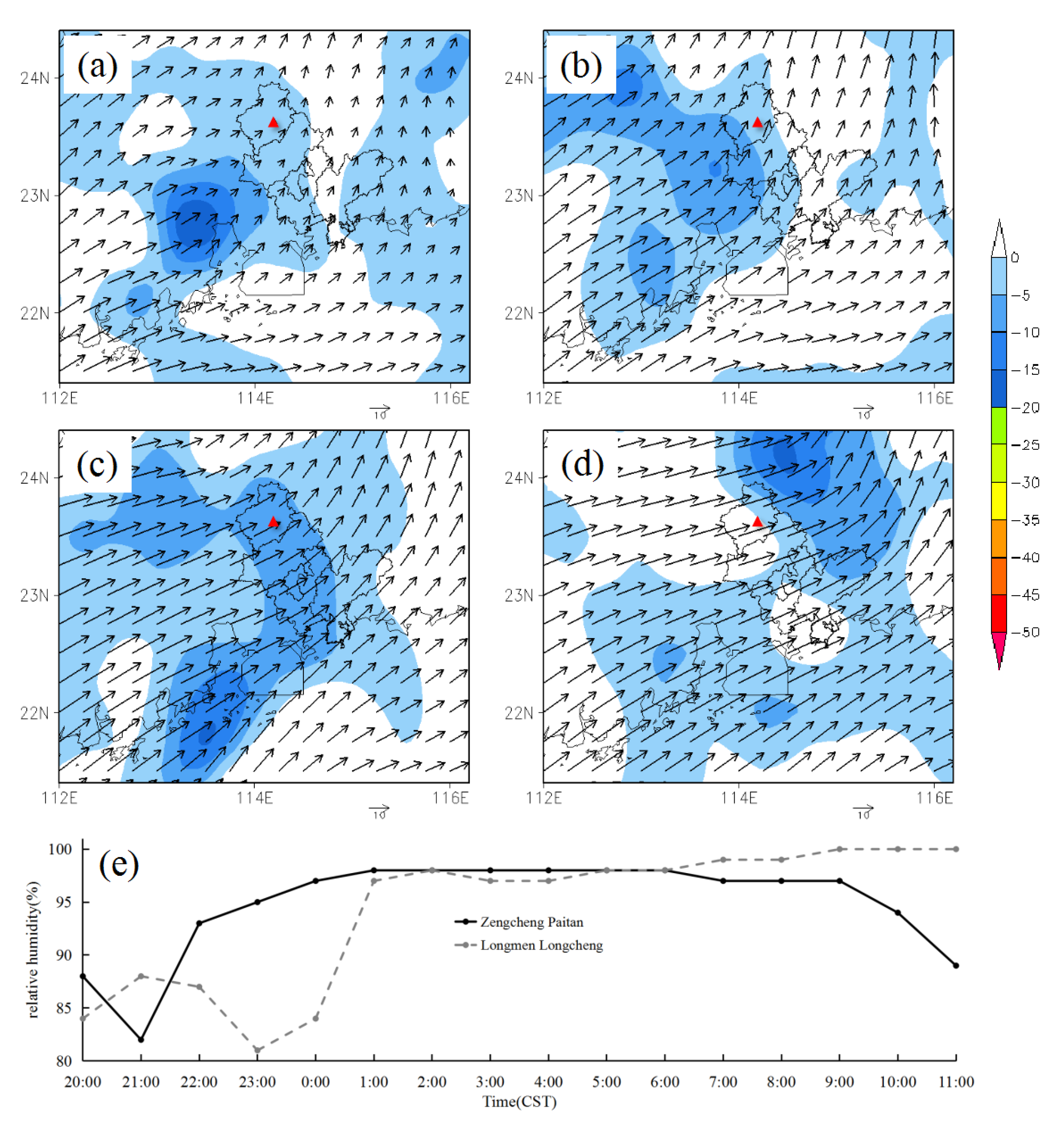
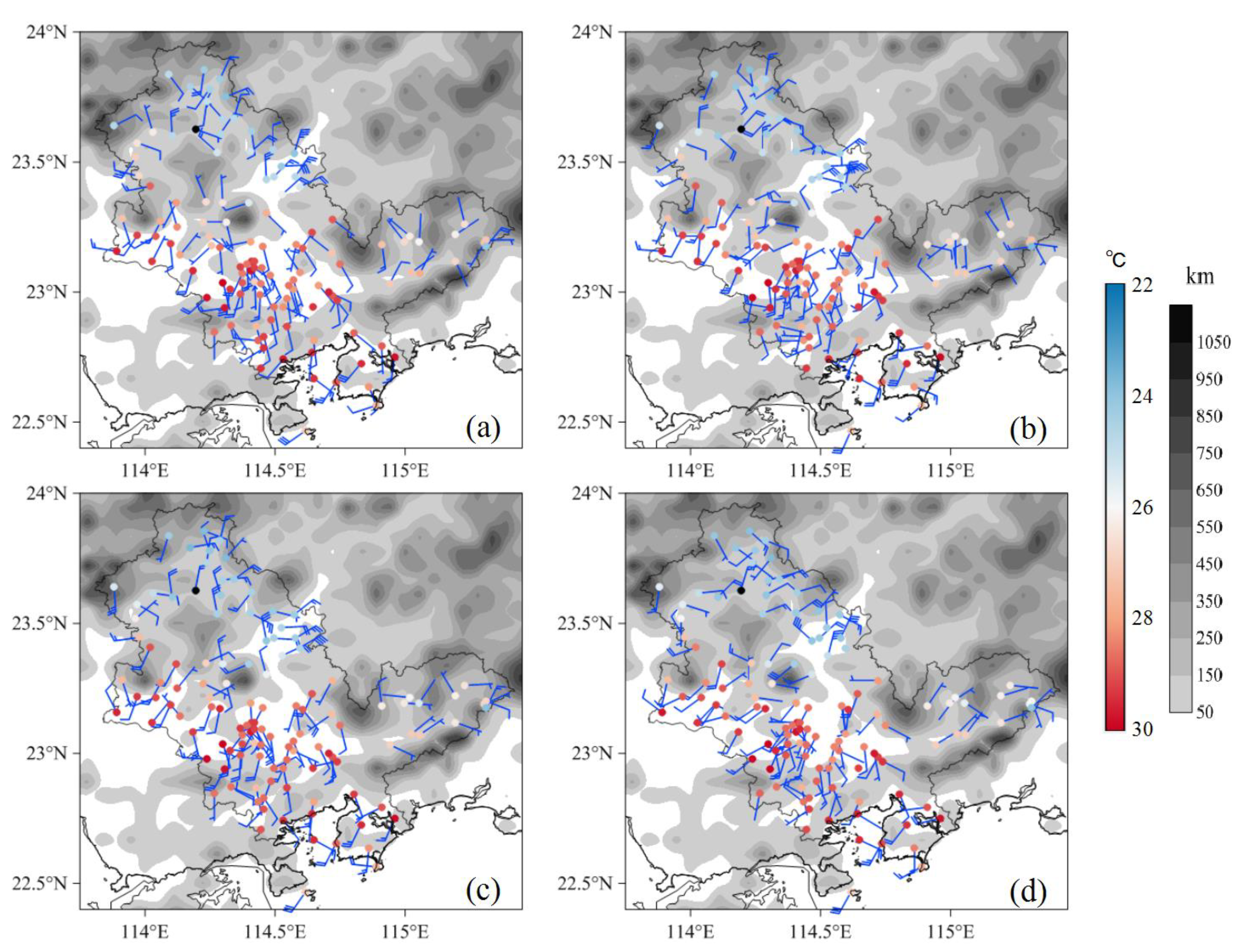



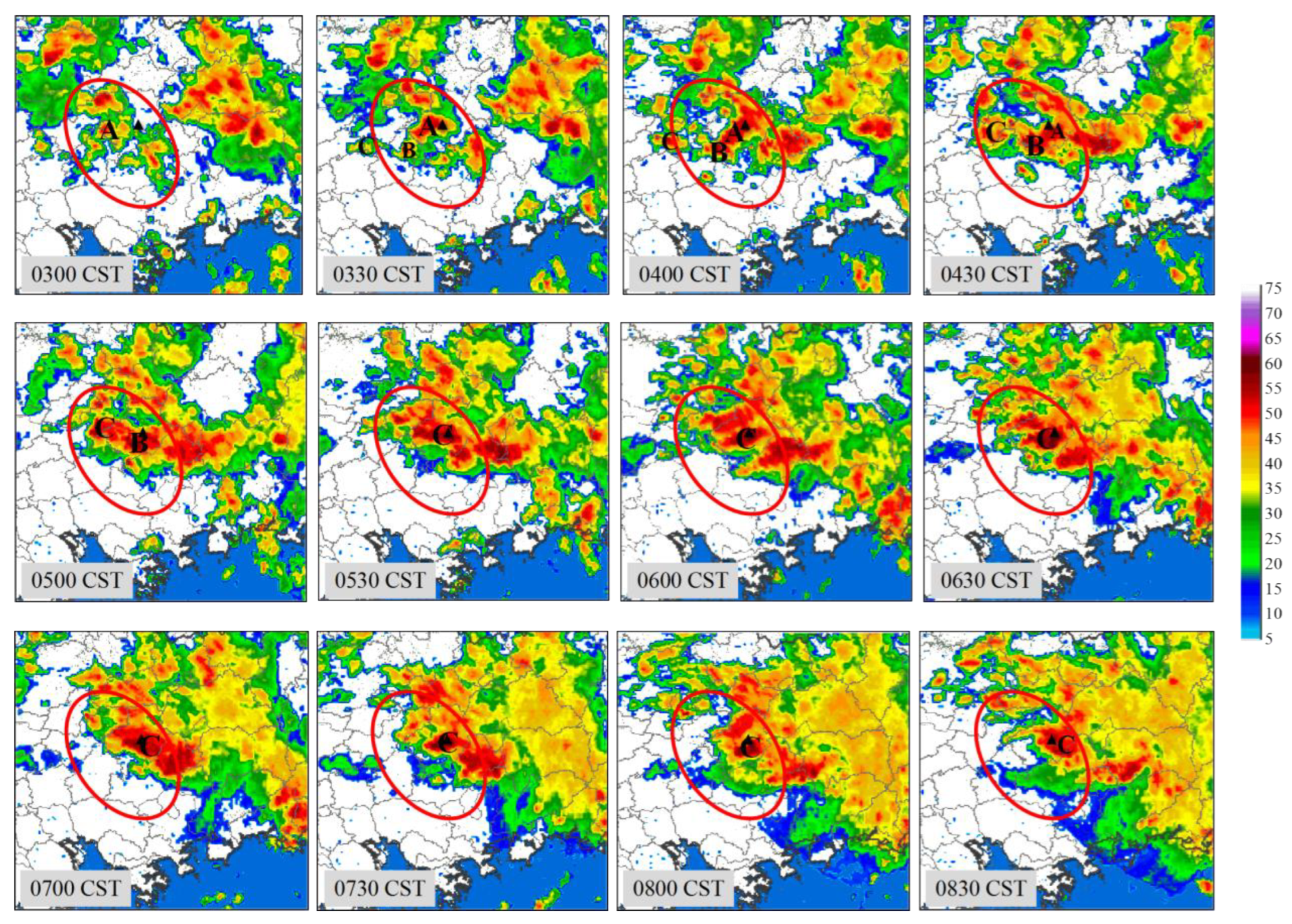

| Stations | 2000 CST on 30 May | 0200 CST on 31 May | 0800 CST on 31 May | |
|---|---|---|---|---|
| Yangjiang | 850 hPa | 9.6 | 9.4 | 12.1 |
| 925 hPa | 7.6 | 6.8 | 8.1 | |
| Qingyuan | 850 hPa | 7.0 | 8.0 | 12.0 |
| 925 hPa | 3.0 | 6.0 | 8.0 | |
| Hong Kong | 850 hPa | 6.0 | 7.0 | 12.0 |
| 925 hPa | 5.0 | 9.0 | 10.0 | |
| Heyuan | 850 hPa | 5.0 | - | 5.0 |
| 925 hPa | 1.0 | - | 6.0 |
Disclaimer/Publisher’s Note: The statements, opinions and data contained in all publications are solely those of the individual author(s) and contributor(s) and not of MDPI and/or the editor(s). MDPI and/or the editor(s) disclaim responsibility for any injury to people or property resulting from any ideas, methods, instructions or products referred to in the content. |
© 2023 by the authors. Licensee MDPI, Basel, Switzerland. This article is an open access article distributed under the terms and conditions of the Creative Commons Attribution (CC BY) license (https://creativecommons.org/licenses/by/4.0/).
Share and Cite
Chen, F.; Li, H.; Hu, S.; Jiang, S.; Li, J.; Wu, R. Formation Mechanisms of the “5·31” Record-Breaking Extreme Heavy Rainfall Process in South China in 2021. Atmosphere 2023, 14, 872. https://doi.org/10.3390/atmos14050872
Chen F, Li H, Hu S, Jiang S, Li J, Wu R. Formation Mechanisms of the “5·31” Record-Breaking Extreme Heavy Rainfall Process in South China in 2021. Atmosphere. 2023; 14(5):872. https://doi.org/10.3390/atmos14050872
Chicago/Turabian StyleChen, Fangli, Huiqi Li, Sheng Hu, Shuai Jiang, Jiaojiao Li, and Ruoting Wu. 2023. "Formation Mechanisms of the “5·31” Record-Breaking Extreme Heavy Rainfall Process in South China in 2021" Atmosphere 14, no. 5: 872. https://doi.org/10.3390/atmos14050872
APA StyleChen, F., Li, H., Hu, S., Jiang, S., Li, J., & Wu, R. (2023). Formation Mechanisms of the “5·31” Record-Breaking Extreme Heavy Rainfall Process in South China in 2021. Atmosphere, 14(5), 872. https://doi.org/10.3390/atmos14050872





